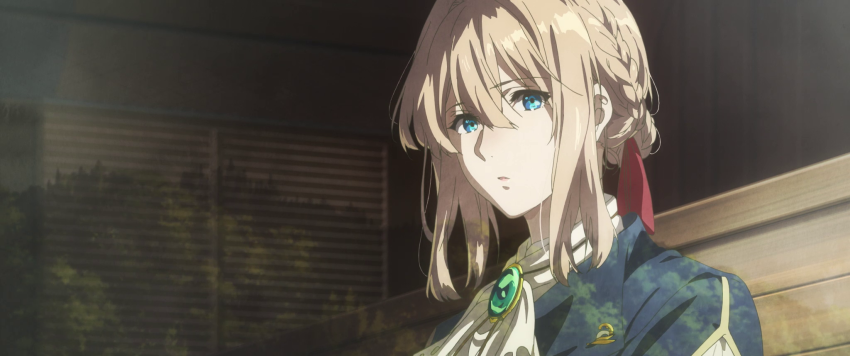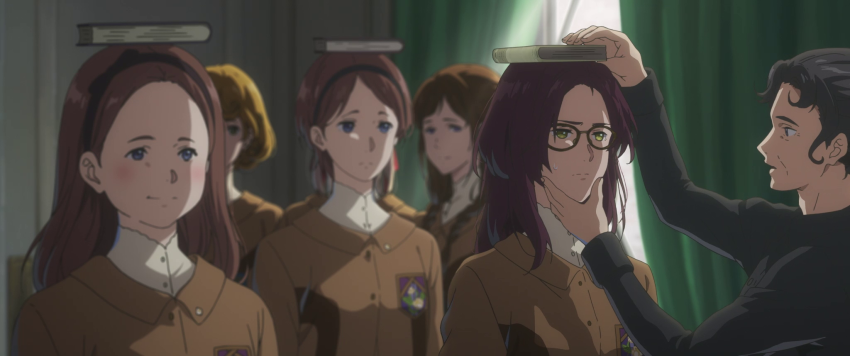Violet Evergarden: Eternity and the Auto Memory Doll
February 20, 2020 · 2 comments
By Andrew Osmond.
 The Kyoto Animation TV series Violet Evergarden was broadcast in Japan in 2017, and was released internationally on Netflix the next year. This film sequel, subtitled Eternity and the Auto Memory Doll, has a very sad distinction. It was Kyoto Animation’s last work to be completed before the murderous arson attack on the studio in July 2019, which killed 36 staff members. But it will not be the last animation made by Kyoto Animation, and it has the ethos which makes the studio’s work live on.
The Kyoto Animation TV series Violet Evergarden was broadcast in Japan in 2017, and was released internationally on Netflix the next year. This film sequel, subtitled Eternity and the Auto Memory Doll, has a very sad distinction. It was Kyoto Animation’s last work to be completed before the murderous arson attack on the studio in July 2019, which killed 36 staff members. But it will not be the last animation made by Kyoto Animation, and it has the ethos which makes the studio’s work live on.
The film assumes broad familiarity with the Violet Evergarden series, though you’d only need to see the first few episodes to be up to speed. Like many of the TV episodes, the film is a largely self-contained story, or arguably a pair of stories, one after another, with a clear link between them. Like many of Kyoto Animation’s works, it’s a very gentle anime. Violet Evergarden is set in a world recovering from war – a war in which the title character was traumatically involved, and parts of the TV series showed Violet’s memories of the conflict. The war is referenced in the film too, but this is a quiet, character-based drama about characters befriending each other, being kind to each other, and finding happiness through kindness – Kyoto Animation’s philosophy to a T.
Like many of the TV stories, the first part of the film involves Violet journeying to a foreign land, to a secluded school for the daughters of aristocrats. She has an unusual task; to help one particular girl become a decorous debutante, trained in posture, etiquette and dancing. The girl, Isabella, is intensely resentful of her teacher, and jealous too. For her, the wide-roaming Violet represents a freedom she can never have. Of course, viewers of the series, in which Violet was shaped and constricted by many influences, know it’s more complex than that; and later Violet will realise she and Isabella had pasts with manys parallels.
This first part of the film will also provoke the most discussion, about what many fans will see as obvious lesbian feelings on Isabella’s part. For some Western viewers, the girls’ boarding school setting is a giveaway in itself. From a Japanese angle, Violet is presented as androgynous in some scenes, especially when she dances “the man’s part” in a lesson with Isabella while other girls look on enviously. It’s a moment which recalls Japan’s stage tradition of Takarazuka musicals, in which some female stars play gorgeous males with legions of female fans. There’s also a palpable echo of one of Takarazuka’s biggest hits, the adaptation of the manga Rose of Versailles, about the French Revolution. The pairing of Violet and Isabella recalls the gallant, beautifully androgynous Lady Oscar and her more vulnerable charge Marie Antoinette.

Then again, the film has the “deniability” of other anime that depict girls’ relationships, such as Kyoto Animation’s Sound! Euphonium (with the bond between that show’s characters Kumiko and Reina) and Ghibli’s When Marnie Was There. It’s not explicitly confirmed that Isabella is gay; instead the story, like Marnie, ends by highlighting a completely different kind of relationship. As with the anime mentioned above (and you could add Hollywood’s Frozen, with its treatment of Elsa), the fan arguments will continue. Is the film’s approach a well-balanced ambiguity, inclusive of both gay and straight readings, or is it a cowardly refusal to embrace values which might scare off parts of the audience?
The second part of the film is less controversial. Set a few years after the first, it mostly takes place in Violet’s home city of Leiden. A very young girl arrives in town, determined to deliver mail just as Violet does. We see this plucky child learning the ropes, doing the footwork (with an adult guardian), and finding addresses in the coastal, European-style city, with beautifully-rendered backgrounds. Inevitably this echoes Kiki’s Delivery Service, one of Ghibli’s sunniest films. But unlike Kiki, the dramatic turning point is not something that happens to the young girl, but rather a surprise decision she makes at the story’s end, which viewers will be discussing as they leave the cinema.
The film is about feelings and how memory does not so much diminish them as blur them through a gauze. The two parts of the film are set a few years apart, but for a young child, that’s enough to turn what were once vivid experiences into barely-conscious impressions which need a trigger to wake them – for example, a name written in a loving letter. The film’s visual metaphors include a giant radio tower being built in the city of Leiden, which looks exactly like the Eiffel Tower. It’s growing like the little girl, of course, but the structure will also remind Japanese viewers of the Tokyo Tower built in the 1950s, during a post-war recovery like the one shown in Violet Evergarden.
The TV series (based on books by Kana Akatsuki) was about Violet trying to recover from horror and grief. Its real resonance was horribly obvious when the film opened in Japan in September 2019. The film was completed shortly before the attack on the studio and it was released just weeks later. It made national news, and was seen by weeping audiences still stunned by the atrocity. The fire’s victims included 35 year-old Mikiko Watanabe – she was the film’s art director, heading up the team which made the beautiful city visuals. Also dead in the fire was 48 year-old Hiroyuki Takahashi, who’d handled the film’s props. Takahashi was previously responsible for the intricate musical instruments in the Sound! Euphonium franchise.
And yet, Kyoto Animation has said it will return, with Violet. A second Violet Evergarden film was in production at the time of the fire. Incredibly, production has resumed since then; as of writing, the new film is scheduled to open in April 2020. When Kyoto Animation announced the new release date, the studio thanked its fans and said its staff were working on the film with all their hearts and strength. The studio has released many beloved anime in its lifetime, from K-ON! to A Silent Voice. Yet Violet Evergarden may become the defining symbol of Kyoto Animation’s survival.
Violet Evergarden: Eternity and the Auto Memory Doll has its UK premiere at the Glasgow Film Festival on 1st March.
geovanna
January 25, 2022 10:01 am
the original story makes obvious what isabella feels for Violet, which is love. She said it a bunch of times that she is in love. Great articule tho, but i totally recommend to check out the Gaiden which tells the original story. dont really know why they choose to hide the feelings of Isabella but
Nanon
April 28, 2022 1:34 pm
If you managed to figure it out, it means that they didn't hide it. They just left it out for the viewer to investigate. Unlike your average modern day American film where they have to lay it out for you to understand because big words hurt the sime people.